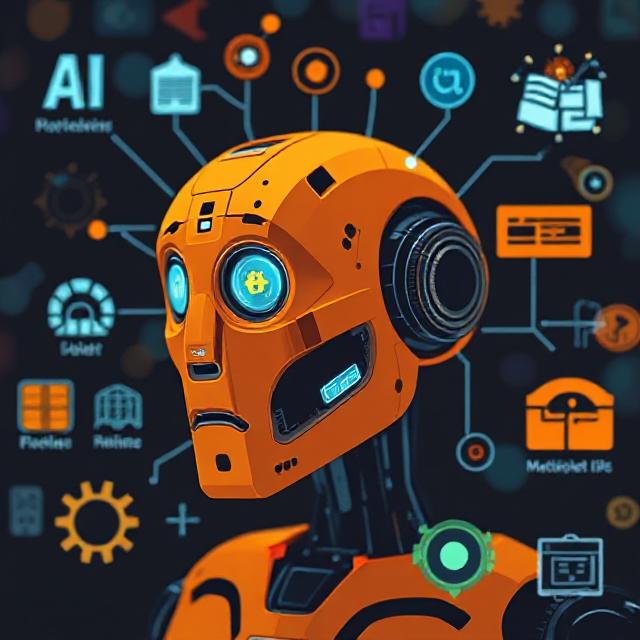7 Secret AI Productivity Tools That Transform Hours of Work Into Minutes: The 95% Don’t Know About These Game-Changers
The digital revolution has reached a tipping point where artificial intelligence is no longer a futuristic concept but an immediate productivity multiplier. While millions of professionals struggle with information overload and repetitive tasks, a select few have discovered AI productivity tools that compress hours of manual work into mere minutes of automated efficiency.
The Hidden Reality: Why 95% of People Miss These AI Productivity Opportunities
The productivity paradox of our modern workplace is striking. Despite having access to more information and tools than ever before, the average knowledge worker spends only 39% of their time on meaningful work, according to recent workplace studies. The remaining 61% gets consumed by administrative tasks, information gathering, documentation, and repetitive processes that could be automated with the right AI productivity tools.
Most professionals remain unaware of these transformative solutions because they’re either buried in specialized communities, marketed to niche audiences, or simply haven’t gained mainstream recognition despite their revolutionary capabilities. This knowledge gap creates an enormous competitive advantage for those who discover and implement these AI-powered efficiency tools.
The transformation isn’t just about saving time—it’s about fundamentally changing how work gets done. When repetitive tasks are automated and information processing is accelerated through artificial intelligence automation, professionals can focus on strategic thinking, creative problem-solving, and high-value activities that truly drive results.
1. Otio: Your AI Research and Writing Accelerator
Otio represents a paradigm shift in how we approach research and content creation. This AI productivity tool functions as an intelligent research partner that can process vast amounts of information, synthesize key insights, and accelerate the writing process by orders of magnitude.
The platform excels at transforming the traditionally time-intensive research process into a streamlined workflow. Instead of spending hours manually reviewing documents, articles, and sources, Otio’s artificial intelligence automation can analyze multiple documents simultaneously, extract relevant information, and create structured summaries that would typically require extensive manual effort.
For content creators, researchers, and knowledge workers, Otio’s writing acceleration capabilities are particularly valuable. The AI system can help generate outlines, suggest relevant information, and even assist with drafting while maintaining the user’s voice and intent. This workflow optimization approach means that projects that once required full days of research and writing can often be completed in a fraction of the time.
The tool’s document analysis capabilities are especially powerful for professionals who regularly work with lengthy reports, academic papers, or complex documentation. By uploading multiple sources, users can quickly generate comprehensive analyses, identify patterns across documents, and create synthesis reports that would traditionally require extensive manual review and compilation.
2. Framedrop: Transforming Video Content Creation Workflows
Video content has become essential for modern marketing and communication strategies, but the editing and optimization process traditionally consumes enormous amounts of time. Framedrop addresses this challenge through AI-powered video processing that can identify the most engaging segments, optimize content for different platforms, and automate much of the post-production workflow.
This productivity software leverages machine learning algorithms to analyze video content and automatically identify compelling moments, potential viral segments, and platform-specific optimization opportunities. For content creators who previously spent hours manually reviewing footage and creating multiple versions for different social media platforms, Framedrop’s intelligent workflow solutions can compress this process dramatically.
The platform’s ability to understand content context and audience engagement patterns makes it particularly valuable for businesses and creators who need to maintain consistent video output across multiple channels. The AI system can automatically generate clips optimized for TikTok, Instagram Reels, YouTube Shorts, and other platforms, each with appropriate formatting and timing adjustments.
Content creators using Framedrop report significant improvements in their content production velocity, with many achieving three to five times their previous output while maintaining or improving engagement rates. This productivity enhancement comes from the tool’s ability to handle the time-intensive aspects of video optimization while allowing creators to focus on content strategy and audience development.
3. Text Blaze: Intelligent Text Expansion and Template Automation
Text Blaze revolutionizes how professionals handle repetitive typing and communication tasks through advanced text expansion and template automation. This AI-driven efficiency tool goes far beyond simple text shortcuts, offering dynamic templates that can adapt to context, incorporate variables, and streamline complex communication workflows.
The platform’s smart automation tools can transform commonly used phrases, responses, and documents into intelligent templates that adjust based on context and recipient information. For professionals who frequently send similar emails, create recurring documents, or work with standardized responses, Text Blaze can eliminate the manual typing while ensuring personalization and accuracy.
One of the most powerful aspects of Text Blaze is its ability to create dynamic content that changes based on variables and conditions. Sales professionals can create email templates that automatically adjust based on prospect information, customer service representatives can use context-aware response templates, and administrative staff can automate form generation and document creation processes.
The productivity gains from Text Blaze compound over time as users build libraries of intelligent templates. Teams that implement comprehensive Text Blaze workflows often report productivity improvements of 40-60% in their communication and documentation tasks, with the time savings allowing for greater focus on strategic activities and customer relationship building.
4. ScribeHow: Automated Process Documentation and Training Materials
ScribeHow addresses one of the most overlooked yet time-intensive aspects of business operations: process documentation and training material creation. This AI productivity tool automatically captures and documents workflows, creating step-by-step guides, standard operating procedures, and training materials without manual documentation effort.
The platform’s innovative approach involves recording user actions and automatically generating comprehensive documentation with screenshots, descriptions, and procedural steps. This workflow optimization eliminates the traditionally labor-intensive process of creating training materials and ensures that documentation stays current with actual practices.
For organizations struggling with knowledge management and employee onboarding, ScribeHow provides a solution that scales documentation efforts without proportional increases in time investment. The AI system can create consistent, professional documentation that would typically require dedicated technical writing resources and significant time allocation.
The impact on training and onboarding processes is particularly significant. New employees can access detailed, visual guides for every business process, reducing training time and improving consistency across teams. Additionally, process improvements and updates are automatically reflected in documentation, eliminating the common problem of outdated training materials.
5. TLDR This: Intelligent Information Synthesis and Summarization
Information overload represents one of the most significant productivity challenges in modern work environments. TLDR This addresses this challenge through advanced artificial intelligence automation that can quickly synthesize lengthy documents, articles, and reports into concise, actionable summaries.
This productivity software excels at processing various content types, from academic papers and business reports to news articles and research documents. The AI system identifies key points, main arguments, and critical information while filtering out less relevant details, enabling professionals to consume information at dramatically accelerated rates.
For executives, researchers, and professionals who need to stay informed across multiple domains, TLDR This transforms information consumption from a time-intensive bottleneck into an efficient scanning process. Users can quickly review summaries of relevant content and dive deeper into specific documents only when necessary.
The tool’s ability to maintain context and preserve important nuances while condensing information makes it particularly valuable for strategic decision-making processes. Teams can quickly review multiple perspectives on complex topics, compare different approaches, and identify consensus or divergence across sources without investing hours in detailed reading.
6. Archive: Advanced Information Management and Retrieval
Archive represents a sophisticated approach to information management that goes beyond traditional filing systems. This AI-powered efficiency tool creates intelligent information repositories that can understand content context, establish connections between related materials, and provide rapid retrieval based on semantic search rather than simple keyword matching.
The platform addresses the common challenge of information silos and lost knowledge that plagues many organizations. By creating comprehensive, searchable archives of documents, communications, and resources, Archive ensures that valuable information remains accessible and actionable over time.
The AI system’s ability to understand content relationships and suggest relevant materials transforms how teams access and utilize their collective knowledge. Instead of spending time searching through folders and trying to remember where specific information was stored, users can quickly locate relevant materials through natural language queries and contextual suggestions.
For teams working on complex projects or dealing with extensive documentation requirements, Archive’s intelligent workflow solutions provide significant productivity advantages. The platform can identify relevant precedents, suggest related resources, and help ensure that valuable institutional knowledge doesn’t get lost or forgotten.
7. Perplexity: Real-Time AI Research and Information Discovery
Perplexity represents the evolution of search and research capabilities, combining advanced artificial intelligence with real-time information access to provide comprehensive, accurate answers to complex questions. This AI productivity tool transforms traditional research processes by providing synthesized information from multiple sources with proper citations and current data.
The platform’s strength lies in its ability to understand context and provide nuanced answers that would typically require consulting multiple sources and synthesizing information manually. For professionals who regularly need to research topics, verify information, or explore complex subjects, Perplexity can compress hours of traditional research into minutes of focused inquiry.
Recent developments in Perplexity’s capabilities, including Deep Research functionality, demonstrate the platform’s evolution toward comprehensive research automation. The system can now conduct multi-step research processes, following information trails and building comprehensive understanding of complex topics with minimal human intervention.
The productivity enhancement from Perplexity becomes particularly apparent in knowledge-intensive work where accurate, current information is essential. Legal research, market analysis, competitive intelligence, and academic research all benefit from the platform’s ability to quickly provide comprehensive, well-sourced information on complex topics.
The Compound Effect: How AI Productivity Tools Create Exponential Time Savings
The true power of these AI productivity tools emerges not from individual applications but from their compound effect when integrated into comprehensive workflow optimization strategies. Organizations and individuals who implement multiple AI-driven efficiency tools often experience productivity improvements that exceed the sum of individual tool benefits.
This synergistic effect occurs because these tools address different aspects of the productivity challenge. While Otio accelerates research and writing, Text Blaze eliminates repetitive typing, ScribeHow automates documentation, and Perplexity streamlines information discovery. When combined, these artificial intelligence automation tools create seamless workflows where information flows efficiently from research through documentation to final output.
The learning curve for implementing these smart automation tools is typically minimal compared to their productivity benefits. Most users report significant time savings within the first week of implementation, with productivity gains continuing to increase as they develop more sophisticated workflows and automation strategies.
Implementation Strategy: Maximizing AI Productivity Tool Effectiveness
Successful implementation of AI productivity tools requires strategic thinking about workflow optimization rather than simply adopting individual tools. The most effective approach involves analyzing current time-intensive processes and identifying where artificial intelligence automation can provide the greatest impact.
Start by conducting a productivity audit to identify tasks that consume disproportionate amounts of time relative to their value creation. Common candidates include repetitive communication, information gathering, document creation, and process documentation. These areas typically offer the greatest opportunities for AI-driven efficiency improvements.
The implementation process should be gradual and systematic. Begin with one or two tools that address your most significant productivity bottlenecks, develop proficiency with those systems, and then expand to additional tools as workflows become optimized. This approach prevents overwhelming existing processes while ensuring that each new tool integration provides measurable benefits.
Training and change management considerations are crucial for organizational implementations. Teams need time to adapt to new AI-powered efficiency tools and develop confidence in delegating tasks to artificial intelligence systems. Providing comprehensive training and establishing best practices helps ensure successful adoption and maximum productivity benefits.
Measuring Impact: Quantifying AI Productivity Improvements
The impact of AI productivity tools can be measured through various metrics that go beyond simple time savings. While reduced task completion time is the most obvious benefit, additional measures include improved output quality, increased task volume capacity, reduced error rates, and enhanced creative focus time.
Time tracking before and after implementation provides clear quantitative evidence of productivity improvements. Many users report time savings of 40-70% on tasks that have been successfully automated or accelerated through AI tools. These savings compound over time as users become more proficient with the systems and develop more sophisticated automation workflows.
Quality improvements often accompany time savings as AI systems can provide consistency, thoroughness, and accuracy that surpass manual processes. Automated documentation is more comprehensive, research synthesis is more systematic, and communication templates ensure consistent messaging and reduced errors.
The most significant long-term benefit is often the reallocation of time toward high-value activities. When routine tasks are automated through intelligent workflow solutions, professionals can focus on strategic thinking, relationship building, creative problem-solving, and innovation activities that drive meaningful business results.
Future Trends: The Evolution of AI Productivity Tools
The trajectory of AI productivity tools suggests continued evolution toward more sophisticated, integrated solutions that can handle increasingly complex tasks with greater autonomy. Machine learning productivity systems are becoming more adept at understanding context, learning from user preferences, and adapting to specific workflow requirements.
Integration capabilities are expanding rapidly, with AI tools increasingly able to work together seamlessly and share information across platforms. This trend toward ecosystem integration will further amplify productivity benefits as tools become more interconnected and capable of handling end-to-end workflow automation.
The democratization of AI capabilities means that advanced productivity tools will become accessible to broader audiences, potentially eliminating the current advantage held by early adopters. Organizations and individuals who establish AI-driven efficiency workflows now will maintain competitive advantages through experience and optimization rather than access to exclusive tools.
Overcoming Common Implementation Challenges
Despite their significant benefits, AI productivity tools face adoption challenges that organizations must address systematically. Common obstacles include technology resistance, integration complexity, data security concerns, and workflow disruption during implementation periods.
Technology resistance often stems from unfamiliarity with AI capabilities and concerns about job displacement. Addressing these concerns requires clear communication about how artificial intelligence automation enhances rather than replaces human capabilities, enabling professionals to focus on higher-value activities while delegating routine tasks to AI systems.
Integration complexity can be minimized through phased implementation approaches that introduce tools gradually and ensure compatibility with existing systems. Starting with standalone tools that don’t require extensive integration reduces implementation risk while providing immediate productivity benefits.
Data security considerations are legitimate and should be addressed through careful vendor evaluation, security policy development, and compliance verification. Organizations should establish clear guidelines for what information can be processed through external AI systems and implement appropriate data protection measures.
The Competitive Advantage of AI Productivity Mastery
Organizations and individuals who master AI productivity tools gain substantial competitive advantages that compound over time. The ability to process information faster, create content more efficiently, and automate routine tasks enables focus on strategic activities that drive superior results.
This competitive advantage becomes self-reinforcing as AI productivity mastery enables handling larger project volumes, responding more quickly to opportunities, and maintaining higher output quality. Teams that effectively leverage these smart automation tools can often achieve results that would require significantly larger traditional teams.
The knowledge gap around AI productivity tools creates temporary opportunities for early adopters. As these tools become more widely known and adopted, the competitive advantage will shift from access to implementation sophistication and workflow optimization expertise.
Conclusion: Transforming Work Through AI Productivity Intelligence
The seven AI productivity tools outlined—Otio, Framedrop, Text Blaze, ScribeHow, TLDR This, Archive, and Perplexity—represent just the beginning of an artificial intelligence automation revolution that is fundamentally changing how work gets accomplished. These platforms demonstrate that the future of productivity lies not in working harder or longer, but in working smarter through intelligent automation and AI-driven efficiency.
The transformation from hours-long manual processes to minute-long automated workflows is not merely about time savings—it’s about reimagining what’s possible when routine tasks are eliminated and human intelligence is focused on activities that truly matter. Organizations and individuals who embrace these AI-powered efficiency tools today are positioning themselves for sustained competitive advantages in an increasingly automated future.
The secret is no longer that these tools exist—the secret is understanding how to implement them systematically, integrate them effectively, and optimize workflows to achieve maximum productivity benefits. As artificial intelligence continues to evolve, those who master these productivity enhancement technologies will find themselves operating at levels of efficiency that seemed impossible just a few years ago.
The choice is clear: continue struggling with manual processes and time-intensive workflows, or embrace the AI productivity revolution that transforms hours of work into minutes of intelligent automation. The tools are available, the benefits are proven, and the competitive advantage awaits those ready to make the transition to AI-driven productivity excellence.












